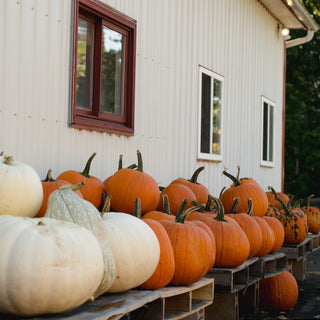Words and photos by Olivia Bauso; Photos taken at Bauman's Farm Market and Schutt's Apple Mill, both located in Webster
September 22nd marks the beginning of the spookiest time of year. Once Fall hits, all of Upstate New York scrambles to snatch the best pumpkins, to pick the tastiest apples and to celebrate their favorite Halloween traditions. This year, take a break from your usual festivities to delve into the history of the season.
 Photo taken at Bauman's Farm Market in Webster
Photo taken at Bauman's Farm Market in Webster
In an animated video and lengthy piece, the History Channel dishes out a detailed scoop on the holiday's history. It all goes back some 2,000 years to the ancient festival known as “Samhain,” which translates to “Summer’s end” in Gaelic. The festival was held on November 1, but people believed that on the night before, the dead returned as ghosts. In order to keep the spirits at bay, families would leave food and wine on their doorsteps, wear masks in order to be mistaken for fellow ghosts and line roads with candles to lead deceased loved ones back to their graves. In the 8th century, the Catholic Church transformed Samhain into “All Saint’s Day,” or “All Hallow’s Day,” which is where we got the term, “All Hallow’s Eve,” now Halloween.
Over hundreds of years, ancient practices of souling (begging for food in exchange for prayer) and guising (dressing in costume and asking for treats in exchange for songs, poetry or jokes) slowly morphed into what we know as American Halloween today -- thanks to Irish-American immigrants in the 19th century. Still, it wasn’t until the 1950’s that Halloween became child and family-centered, when it became far more about the treats than the tricks.
 Photo taken at Bauman's Farm Market in Webster
Photo taken at Bauman's Farm Market in Webster
Though trick-or-treating has become friendlier in modern practice, Halloween has always been a holiday filled with mystery, magic and superstition (a holiday centered around avoiding the dead will do that!). Folklorist John Santino tells Live Science, "Halloween provides a safe way to play with the concept of death."
Beyond testing the limits of the dead, other superstitions have become associated with Halloween. Black cats have played a large role in folklore and mythology for centuries, and are now the quintessential contemporary Halloween icon. Don’t be fooled by the cuteness of elementary students’ with whiskers, though: black cats are traditionally associated with Satan, witches, and witchcraft! Or, at least they were in the Middle Ages. Santino and the History Channel curators concur, people went as far as to say black cats were witches incarnate or supernatural servants to witches because they are nocturnal and roam at night. The widespread superstition lead to a horrific mass killing of black cats -- and even some owners! -- during the Middle Ages.
Today, most people have disassociated the furry animal with sorcery, but still carry a hint of superstition towards them. The Spruce says many animal shelters will even hold back from placing black cats in homes during October, for fear owners may be using them sacrificially. Now that’s spooky.
 Photo taken at Bauman's Farm Market in Webster
Photo taken at Bauman's Farm Market in Webster
Want to dive deeper into Fall? Dried Wreath Making with Flowerwell (Oct 21).
Interested in taming your black cat? Check out our upcoming class, Cats 101: Reading Your Cat’s Behavior + Basic Training (Oct 23).
Are cocktails more your style? Check out Spooktacular Creations with Flower City Drinksmiths (Oct 24).
Looking to tap into your sixth sense? Try Your Sixth Sense: Trick or Treat (Oct 30).



